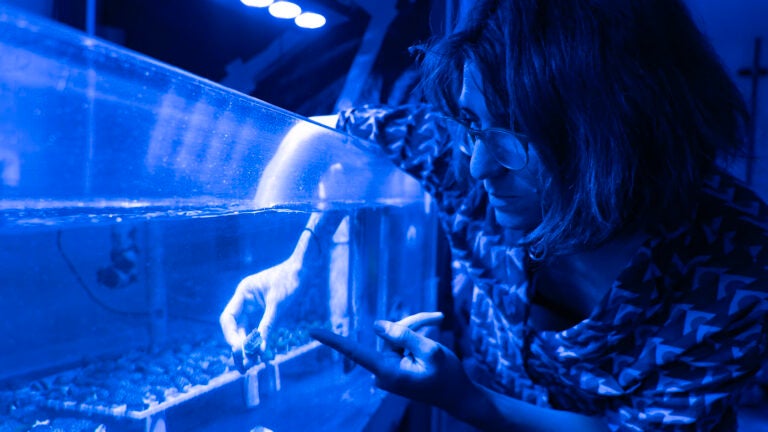
2024 Wrigley Institute Graduate Fellow Maya Gomez, a PhD student in the Marine & Environmental Biology Program, examines Staghorn coral to better understand how changes in morphology helps them survive rapid environmental change. (Nick Neumann/USC Wrigley Institute)
Tiny sculptors with an immense job: building reefs — Coral morphology and how it changes alongside the environment
I have always been enchanted by intricate details of the natural world–insights unveiled after careful regard. In my PhD research, I am asking questions of these details. Questions like: What function do they serve? How do they arise? In what ways might an individual detail contribute to something greater than itself? Can these details change? And what does it mean if they do?
I am applying these questions to an animal with an impressive and essential job: to build reefs.
Throughout their lifetime, stony corals produce a calcium carbonate skeleton. As a coral grows, complex morphologies take form, including mounds, branches, and plates. This process of skeletal formation is energetically expensive, and much of the funds come from the symbiotic relationship that corals have with a photosynthesizing microalgae. As these individual structures are built overtime and in synchrony with one another, a reef can form. Thus, there is an essential link between individual coral morphology and ecosystem function.
In other words, the 3D structures that corals create is synonymous with the function of a reef. This morphology is what creates habitats, provides homes to an incredible amount of diversity, supports fisheries, and protects coasts from storms. Unfortunately rapid environmental change threatens coral and therefore reef ecosystems as a whole. However, corals may survive this rapid environmental change through plasticity, or within-generation adaptation to their environment.
We see visual evidence of plasticity through changes in an individual coral’s morphology as it experiences different environmental conditions. For example, certain species have been observed to grow in plate-like sheets under low light, but branch under high light. In making these morphological changes, the coral influences the internal light environment experienced by the tiny algae living in their tissues. The coral can mediate sun exposure by either increasing surface area in alignment with the sun or producing structures that offer shade.
Flow is another environmental queue that can impact growth formations, and has been found to trigger changes in branch spacing and subsequent flow rates within the colony itself–which can influence prey capture. Previous work from our lab linked the ability for a coral to modulate its growth to higher survival.
My dissertation work aims to untether the mechanisms underpinning morphological plasticity–an ambitious goal made attainable through the support of the Wrigley Institute for Environment and Sustainability, the Cnidarian Evolutionary Ecology lab, and mentorship of Dr. Carly Kenkel. Now entering the third year of my PhD in the Marine & Environmental Biology program, I am on a clear path to answer these questions.
I am using Staghorn coral, a Caribbean branching species, as a model to better understand the intricacies of these changes in morphology. I look at how details, pieces and parts fit together to construct complex skeletal structures, and how the form and function of these details change along with changes in the environment. I build connections between different scales of organization, spanning from individual coral polyps (a single anemone-like unit of a coral), to branches, colonies, and ecosystems. Then, I add an additional layer to my research by exploring how genetically-distinct corals of the same species might navigate changes in the environment differently.

This summer, I am using micro-CT technology to evaluate micro-level changes in Staghorn coral skeleton formation occurring as a result of changes in the flow and light levels of their growing conditions. Some of the things I look for include changes to internal pore structures, features of the canal that spans the length of a branch, aragonite density (a form of calcium carbonate), and more.
Working with Dr. Aaron Celestian at the Natural History Museum, we will also investigate whether or not there are changes at the mineral crystal and elemental levels. By connecting microscopic skeletal changes with large-scale changes in growth formation documented with 3D models, I aim to build an explanation for how a coral is able to modulate its growth formations at the level of calcification.
Then, through the use of sequencing technology, I aim to uncover how changes in skeletal characteristics are controlled at the cellular and gene level–and of course, how all of these different mechanisms might change based on the individual coral.
Understanding the drivers of morphological plasticity will provide insight into our understanding of coral and ecosystem structure and function, how this structure and function may change alongside a changing climate, and what adjustments we can make to reef restoration techniques to cultivate the healthiest, most structurally complex, and resilient reefs.

NOTE: This summer and the timeline of my dissertation research looks different than expected. My original summer plan was to facilitate an experiment to identify the molecular pathways that initiate the change from a regular polyp to the sudden emergence of a branch. However, after ocean temperatures reached the upper 90’s and 100’s in areas of Florida and the Caribbean last summer (2023), a large portion of the Staghorn coral used for reef restoration and research did not survive. As I wait for populations to recover from last summer, I anxiously watch ocean temperatures in this region creep up once again. I am given hope by the amazing people that I meet and learn from everyday, including the phenomenal Wrigley fellows and speakers that joined us throughout the spring. This fellowship has encouraged me to be brave, to speak up, and to build connections. I am now honored to be a mentor for summer students and encourage the same.
Maya Gomez is supported by the USC Dornsife Wrigley Institute Graduate Fellowship.